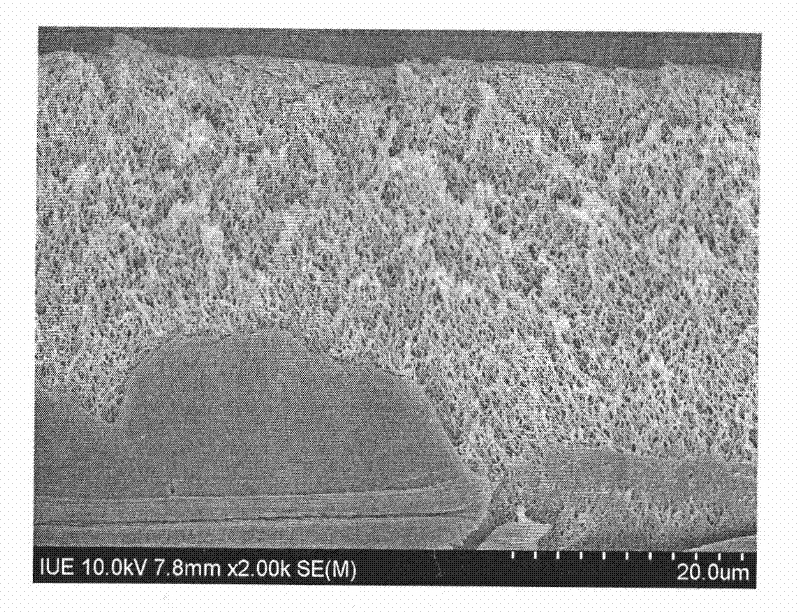Preparation method of nanofiltration membrane for dye concentration and desalination
A nanofiltration membrane and membrane-forming technology, applied in the field of membrane separation, can solve the problems of poor product quality consistency, low product purity, and product quality restrictions.
- Summary
- Abstract
- Description
- Claims
- Application Information
AI Technical Summary
Problems solved by technology
Method used
Image
Examples
Embodiment 1
[0015] Example 1, dissolve 7g of lithium chloride and 1g of polyvinylpyrrolidone in 74g of N,N-dimethylacetamide, then add 18g of aromatic polyamide, dissolve the mixture at a constant temperature of 90°C, and vacuum defoam , to prepare the casting solution. Put a certain amount of the prepared film casting liquid into the trough, use the polyester non-woven fabric as the support layer, and control the film thickness to 0.2 mm by a feeler gauge. After the casting solution is applied to the non-woven fabric, it stays in an oven at 90°C for 0.3 minutes to evaporate part of the solvent, and then enters the gel bath to solidify to form a film. The prepared membrane was placed in pure water for more than 24 hours to completely remove excess organic solvent. Under the pressure of 0.6MPa, the pure water flux of the membrane is 150.8L / m 2 h. Use 2000mg / L of Na 2 S0 4 The solution was tested with a flux of 183.1L / m 2 h, the rejection rate is 6.7%. Under the operating pressure of ...
Embodiment 2
[0016] Example 2, dissolve 5g of lithium chloride and 3g of polyvinylpyrrolidone in 74g of N,N-dimethylacetamide, then add 18g of aromatic polyamide, dissolve the mixture at a constant temperature of 90°C, and vacuum defoam . Put a certain amount of casting solution into the trough, use polyester non-woven fabric as the support layer, and control the film thickness to 0.2 mm with a feeler gauge. After the casting solution is applied to the non-woven fabric, it stays in an oven at 90°C for 0.3 minutes to evaporate part of the solvent, and then enters the gel bath to solidify to form a film. The prepared membrane was placed in pure water for more than 24 hours to completely remove excess organic solvent. Under the pressure of 0.6MPa, the pure water flux of the membrane is 112.1L / m 2 h. With 2000mg / L Na 2 SO 4 The solution was tested with a flux of 108.2L / m 2 h, the rejection rate is 7.9%. Under the operating pressure of 0.6MPa, the flux of the membrane to 1g / L chrome blac...
Embodiment 3
[0017] Example 3, dissolving 6g of lithium chloride and 2g of polyvinylpyrrolidone in 74g of N,N-dimethylacetamide, then adding 18g of aromatic polyamide, dissolving the mixture at a constant temperature of 90°C, and vacuum defoaming . Put a certain amount of casting solution into the trough, use polyester non-woven fabric as the support layer, and control the film thickness to 0.2 mm with a feeler gauge. After coating the casting solution on the non-woven fabric, stay in an oven at 90°C for 0.4min to evaporate part of the solvent, and then enter the gel bath to solidify to form a film. The prepared membrane was placed in pure water for more than 24 hours to completely remove excess organic solvent. Under the pressure of 0.6MPa, the pure water flux of the membrane is 97.2L / m 2 h. With 2000mg / L Na 2 SO 4 The solution was tested with a flux of 99.9L / m 2 h, the rejection rate is 7.6%. Under the operating pressure of 0.6MPa, the flux of the membrane to 1g / L chrome black T d...
PUM
| Property | Measurement | Unit |
|---|---|---|
| thickness | aaaaa | aaaaa |
Abstract
Description
Claims
Application Information
 Login to View More
Login to View More - R&D
- Intellectual Property
- Life Sciences
- Materials
- Tech Scout
- Unparalleled Data Quality
- Higher Quality Content
- 60% Fewer Hallucinations
Browse by: Latest US Patents, China's latest patents, Technical Efficacy Thesaurus, Application Domain, Technology Topic, Popular Technical Reports.
© 2025 PatSnap. All rights reserved.Legal|Privacy policy|Modern Slavery Act Transparency Statement|Sitemap|About US| Contact US: help@patsnap.com



